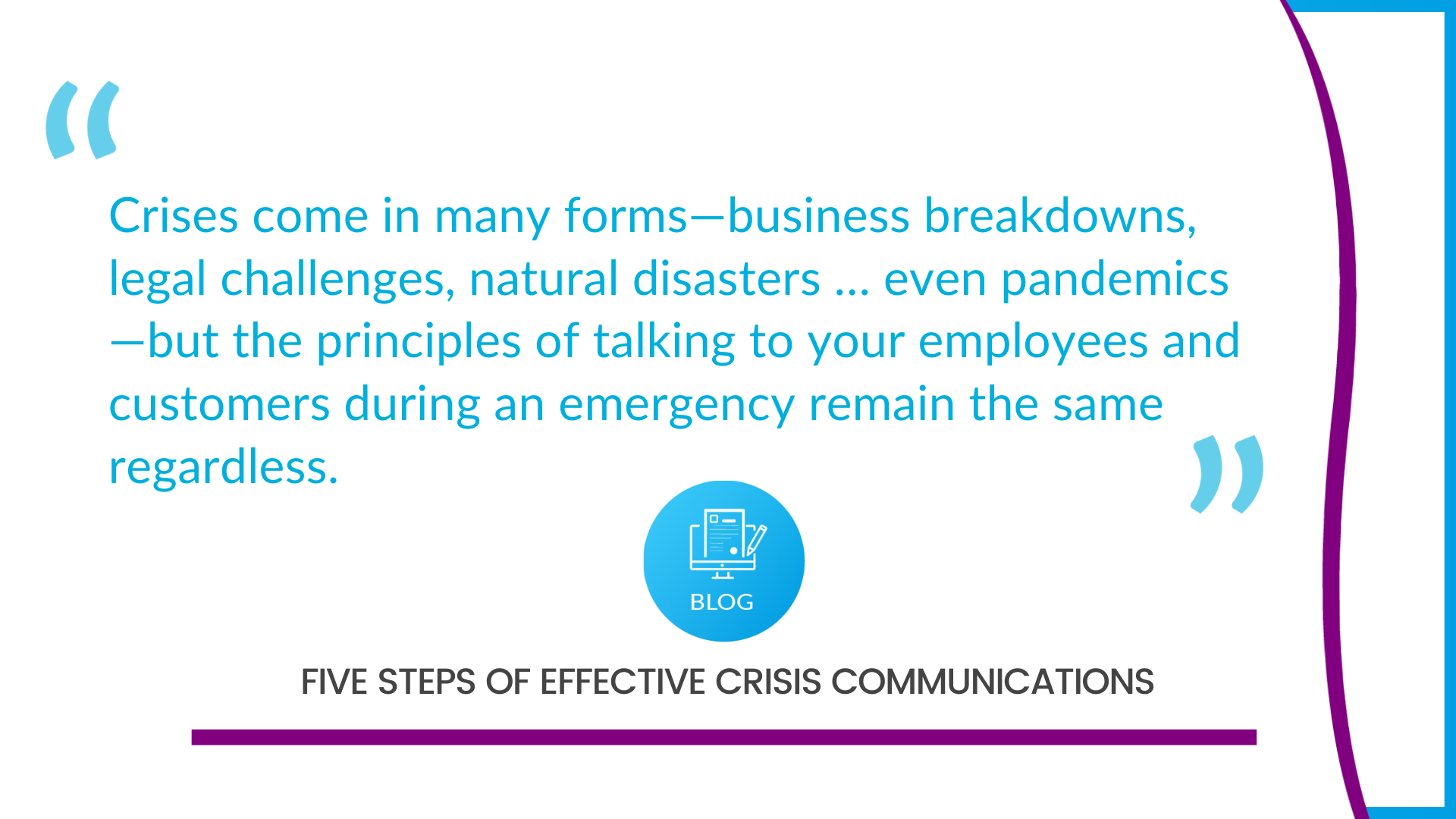Five Steps of Effective Crisis Communications
Crises come in many forms—business breakdowns, legal challenges, natural disasters … even pandemics—but the principles of talking to your employees and customers during an emergency remain the same regardless.
Tell them what you know as soon as you know it
While you want to make sure your business leaders are clear on the details of an emergency, as well as the next steps before communicating to your internal audience, but you can’t wait until everything is perfect. Crises are fluid, and your strategy will likely evolve. Strive to keep people informed, let them know you’ll keep them updated as best you can. This can require a balance of patience and urgency.
Also, don’t be afraid to say you just don’t know. Crisis situations have many variables, and you may simply have to say “I don’t have those details yet.” It can take time to determine what has caused an outage or breach when you are dealing with technology or to be able to fully understand the amount of damage that has been done in the case of a natural disaster. Acknowledging that goes a long way in gaining your audience’s trust. That leads us to the next point:
Be transparent, genuine, and positive
So often, communicators and leaders overthink the message. Trust your instincts, and talk from the heart. Be thoughtful of everyone’s point of view and how any situation can have a different impact on individuals. Talk to your audiences with empathy and openness and be authentic. If you have to spend hours figuring out what to say, you probably have strayed off the path of genuine communication. Most of us know what to say if we think with our hearts.
Take a minute to think about what each audience needs
Before you address either your internal team or external audiences, make sure you know who you are talking to and tailor the information you share to that audience. Internal teams need different information than external audiences such as media or customers. Thinking critically about what info each set of constituents needs, then be concise and offer as many details as you can. Make sure it’s clear that questions are welcome. Also, share the expected timeline for additional updates—hourly, twice daily, etc.—and stick to that schedule as closely as you can.
Balance consistency with agility and flexibility
There is a fine line between spamming and nurturing—and crisis communications are no different. As with any communication, be sure you have value to offer—new information, new details, etc. Don’t email just to check the box. Also, remember that the cadence of communication may ebb and flow as the situation evolves. You may see a need for hourly updates in the early stages, but slowly back down to twice daily, daily, and weekly as urgency lessens.
Other tips for communicating through a crisis
- Leverage a mix of media to your advantage. Use Twitter or Facebook for quick updates, then follow up with a more detailed message once all the details are in place. Time briefings or email updates to media around their schedules—sending them an update at quarter to 5 isn’t useful. Aim to hold any press conferences at 10-11 a.m. and/or 3-4 p.m. for media convenience.
- Don’t get bogged down with perfection. Keeping your team and customers up to date is your primary goal, and while you need to pause to ensure accurate information, you can always add more details as the situation calls for rather than waiting for the full story before you communicate. That delay gives gossip and misinformation a chance to take root.
- Determine your communication lead immediately. Select one person to write your communications and serve as a clearinghouse for updates so you can be certain the message is straight across all your media—website, social, press releases, and communications to your key audiences.
- Have one spokesperson. When you are managing a situation where details are changing quickly, you will want to have one person serve as the face of your company to clarify the message. You are much more likely to have aligned communications if one person is coordinating and one person is doing all the talking—and that may be the same person in a small organization.
- Pause for strategy before you start to type. I know it can feel awkward to raise your hand during an emergency and say: We need to stop for a second. But hitting the pause button to provide everyone a chance to get on the same page BEFORE you start your outreach is essential. It sure beats having to go back and fix mistakes.
Keeping these ideas top of mind will help you stay focused and successful. And remember, for many businesses, the biggest struggle with crisis communication is having a plan in place long before you need it. Ideally, your crisis communication strategy is a key element in your incident response strategy—with everyone aware of who is responsible for each step.
Tag:communications, crisis, marketing

